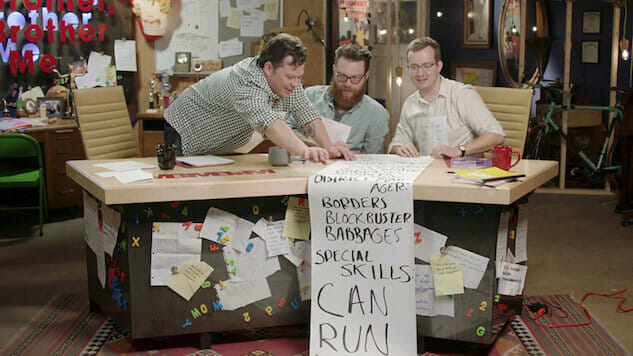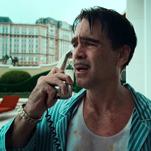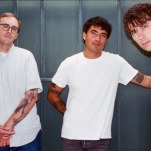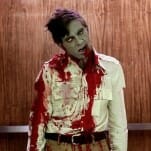The McElroy Brothers Finally Made a TV Show about the McElroy Brothers
Images c/o Seeso.
There are three McElroy Brothers, or at least three you need to know about right now. Their names, in the order they emerged into this world, are Justin, Travis and Griffin. Travis is the one with the beard; Justin and Griffin are the other two. They are the hosts of the podcast My Brother, My Brother and Me and, in various permutations alongside their spouses and friends, a sprawling network of other podcasts: The Adventure Zone, Shmanners, Sawbones, Rose Buddies and the tremendously titled Til Death Do Us Blart. They are also the creators and stars of Seeso’s new unscripted comedy series My Brother, My Brother and Me, a loose and limber adaptation of their flagship podcast, which premieres on the streaming platform today.
In the tradition of creator-driven episodic realityish comedies like Nathan For You and Billy on the Street, My Brother, My Brother and Me is what the Brothers describe as a comedy advice show. As in the podcast, which over seven years has amassed more than 300 episodes, they take audience-submitted queries and riff their way to a solution. In half-hour episodes, this usually requires setting some outlandish goal peripherally related to the inciting question: changing the national conversation around tarantulas to help a guy whose partner doesn’t want him to adopt a tarantula, for instance, or padding their résumés with a litany of odd jobs to prove to a job-seeker that it is possible, nay, easy to pad one’s résumé (if you have a TV crew). The series is set in their hometown of Huntington, where at the end of most episodes they reconnoiter with their father, a local radio host, to unpack the day’s adventures. It’s goofy and imaginative, filled with meta-humor and star wipes, hijinks and locals glancing bemusedly at the camera. Also, Lin-Manuel Miranda guest stars.
“Someone recently described the first episode, and by extension the series, as Portlandia meets Viva La Bam,” said Justin in a recent interview. “The fact that that is not entirely inaccurate shows how hard it was to come up with what the show would be.” The brothers recounted a series of discarded conceptualizations—“straight bricks,” as Griffin called them—that led up to the final format: a prank show, a scripted sitcom (in one which brother is married, one is dating and the other’s single) and an animated rendering of the podcast were all tossed out the window as they figured out how to recapture in television what makes their podcast—podcasts—so wildly popular. “With the podcast, we’ve pretty much figured out what it’s like to sit down and record an episode,” said Justin. “To then be warped back to day one of sitting down to make the TV show—to realize, “what does this looklike?—we had to figure out the rhythm all over again. It was very interesting.”
The Brothers were shepherded through these growing pains by their director and show-runner, JD Amato, noted cool website haver and executive producer for The Chris Gethard Show, which shares many tonal elements (and, one suspects, budget limitations) with My Brother. Amato, who had previously listened to the podcast, helped assuaged the Brothers’ anxieties about making unscripted television. “I think the thing we got hung up on early was the idea that we needed a bunch of things planned, or we needed recurring bits, or a structure to it,” Justin recalled. “JD was the one who sold us on using as little structure as humanly possible and just being willing to follow where it went.” Practically speaking, this meant loosely planning the shape of each episode in development and then improvising in production, with the support of local participants who knew roughly what they were in for but not much more. In one episode, for instance, they set up a meeting with Huntington’s real-life mayor, who has no idea they’re about to ask him to temporarily cede power for the good of the joke; he gamely offers them a minute of honorary collective mayorship. “Whenever our ideas were shot down, I think it made it even funnier,” Griffin said. “Our format is not defined so much by our vision but rather our limitations,” echoed Justin. “We carved away until we found the narrow shred by which our limited skill set [Ed. note: Oh, come on.] could create a television show.”
As it does in Nathan For You, the improvisatory approach also results in (metaphorical) heaps of unused footage. “We filmed 20 hours for each episode and then used, you know, 25 minutes of footage,” said Travis. “We were really learning how to ride a bike. It makes you feel like a child, sometimes.” Of course, that childlike feeling—of discovering what a thing fundamentally is as you’re making it, or in our case consuming it—is precisely what makes My Brother, like their podcasts, so delightful. The humor comes less from mathematical punchlines and joke-escalations than from the Brothers’ individual and collective personalities, the narrative flights of fancy they dream up (like a spider parade) and the obstacles they run up against (like only having a minute to enact city reforms), their refusal to even pretend that they know how to make a conventional show. It is, as Travis proclaimed, a “goulash” of every show that has ever influenced them—from TGIF to MST3k—channeled through their distinct chorus of voices. “One of the things we talked about was Peewee’s Playhouse,” Travis said. “That idea of, ‘In this room, your weirdness is normal. This is the place where we all hang out and be kind of silly and dumb for a half hour.’” In My Brother, My Brother and Me that place is Huntington, West Virginia: Cabell County seat, home of the regionally-famous Big Sandy Superstore Arena, site of the world’s first tarantula parade. Also, Lin-Manuel Miranda guest stars.
My Brother, My Brother and Me is now streaming on Seeso.
Seth Simons is Paste’s assistant comedy editor. Follow him on Twitter.







































